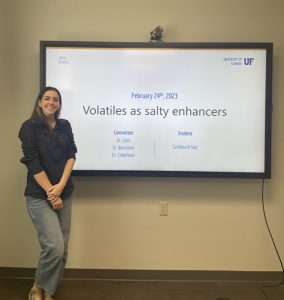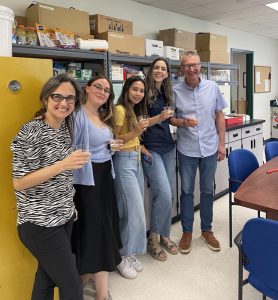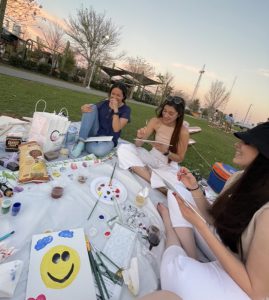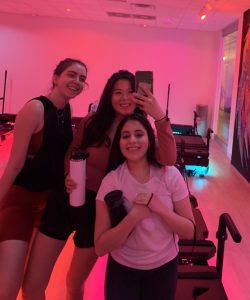 We are so pleased to welcome back Carolina Krivoy Sekler to our Research Journeys series, which follows the research of graduate students in the Food Science and Human Nutrition program at The University of Florida. During the first year of her food science master’s degree program, Carolina described her research into saltiness-enhancing volatiles and how they can improve consumer health.
We are so pleased to welcome back Carolina Krivoy Sekler to our Research Journeys series, which follows the research of graduate students in the Food Science and Human Nutrition program at The University of Florida. During the first year of her food science master’s degree program, Carolina described her research into saltiness-enhancing volatiles and how they can improve consumer health.
This year, Carolina reflects on the results of her research, suggests projects that could build on her research, and offers her top three tips for new graduate students.
When we last heard from you, you were exploring the potential of saltiness-enhancing volatiles to improve our health. What did you discover over the past year?
My thesis results provided new insight into the saltiness enhancement effect by specific volatiles, as well as a deeper understanding of the taste and retronasal olfaction relationship. This work continued Kaipeng (Kevin) Xu’s research for his UF master’s thesis, which similarly employed the nose bump technique to assess the separation of saltiness perception and flavor of a variety of foods.

For my first experiment, I purchased ten commercial flavor systems based on Xu’s thesis results: blue cheese, peanut, sundried tomato, soy sauce 1, soy sauce 2, smoked gouda, sharp cheese, vine-ripe tomato, tomato paste, and ham. In taste panels, all ten samples significantly enhanced saltiness. The soy sauce 2 and soy sauce 1 samples had the highest saltiness enhancement percentage: 38.9% and 26.5%, respectively.
Tell me about some of your other experiments.
For my second experiment, I evaluated tomato paste, vine-ripe tomato, and both soy sauces using Gas Chromatography-Mass Spectra (GC-MS) to identify and quantify their saltiness-enhancing volatiles. The results showed that 22 volatiles detected in these commercial flavor systems enhance saltiness perception. I used five samples during the sensory panel: volatiles from soy sauce, volatiles from tomato, mix (soy sauce + tomato volatiles), overlap (six of the same volatiles in soy sauce and tomato samples, as identified by GC-MS), and salt control.
Mix (soy sauce + tomato volatiles) and tomato volatiles had the highest saltiness enhancement percentage: 27.4%, and 24.4%, respectively. The three samples vary in the number of volatiles (soy sauce: 15 volatiles, tomato: 13 volatiles, and the mix: 22 volatiles), suggesting that an optimal volatile combination containing minimal volatiles (such as the soy sauce and tomato samples) can enhance saltiness as well as a “mix solution” that includes many volatiles (such as the Mix sample).
For my third experiment, I decided to evaluate saltiness-enhancing volatiles in the soy sauce and tomato systems that I hadn’t identified through GC-MS but that are found in other studies. The results showed that the soy sauce, tomato, and mix (tomato+ soy sauce) volatile samples had a significant saltiness enhancement effect. The mix (soy sauce + tomato volatiles) and tomato volatiles had the highest saltiness enhancement percentage values: 27.4%, and 27.3%, respectively.

How has your research project changed from your first semester? Why did it change?
The main objective and purpose of my research did not change. Along the way, we decided on each experiment’s objective and methodology before running the experiment. We held a lot of benchtop/informal sensory panels at my lab before running the large panels with trained panelists.
What are the next steps with your research?
Since I am a master’s degree student, my thesis work is done. I wanted to keep doing research and experiments, but my limitation was time. However, I think there is a lot of future research to do following my results. For prospective graduate students, I suggest identifying which specific volatiles used in the second and third experiments contribute to the saltiness-enhancement effect. The difficulty for this research is that every possible combination with those volatiles needs to be tested to identify which ones enhance saltiness.
Moreover, I suggest applying these saltiness-enhancing volatiles in food products. Some limitations are that not all volatiles behave the same in different matrixes, and volatiles provide flavor, affecting the overall flavor of the food product.

How do you relax and recharge while working on your research project?
A routine that includes everything necessary (exercise, work, social life) is vital to relax and recharge and keep my stress level low. I had a routine that included Pilates classes (working out) five or six times a week for my physical and mental health. I took these classes in the morning before starting my day at university. When I got to the office, I always made a to-do list and prioritized the tasks. Every night I prepared dinner and ate with my boyfriend and brother. On weekends, I tried to make some plans to spend time outdoors and hang out with my friends.
What are the top three things you wish you had known going into your graduate program?
- Your research is going to be something other than your idea. I thought I was the one who needed to provide ideas for my thesis research, but the lab you are joining has already been working on projects, sometimes for years. In addition, you might be under a grant that decides your project. However, my professors gave me a few project ideas, and I was able to choose the one that most interested me.
- Do a good job writing your proposal and start writing your thesis as soon as possible. A good proposal document helped me a lot when writing my thesis.
- Organize your results in a way that makes it easy to remember what you did many months ago. I was perplexed because I did not have the methodologies and results of my experiments well organized. It caused me a lot of stress when I started writing my thesis. I recommend that all students create folders and names with the dates for each experiment.
Is there anything else you would like to add about your experience in the UF/FSHN graduate program?

I loved these two years of experience in the graduate program. Everything went by quickly, so enjoy this experience to the fullest, even though it can be stressful. This master’s degree program made me grow a lot personally and professionally. I’m sure the new friends I’ve made will be friends for life.
Looking for more posts exploring graduate research projects in the Food Science and Human Nutrition Department at the University of Florida?
Revisit Carolina’s first year in the food science M.S. program here. She pursued her degree under the mentorship of Dr. Charles Sims and Dr. Linda Bartoshuk.
Dive into the Research Journeys of other graduate students below.
M.S. Food Science
M.S. Nutritional Sciences
Ph.D. Food Science
Ph.D. Nutritional Sciences
 2
2
